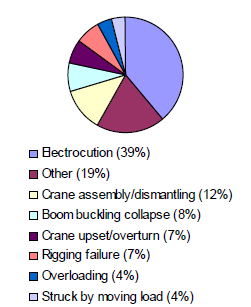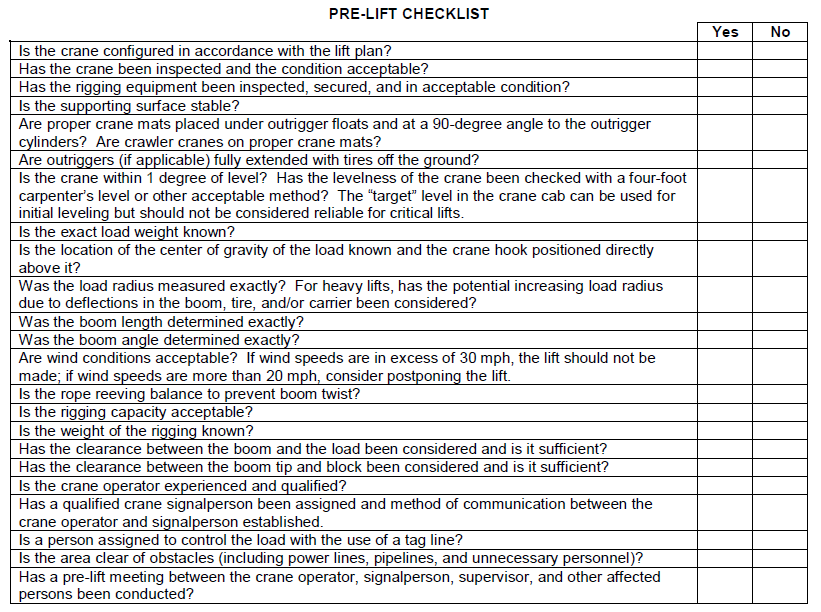JEROME E. SPEAR, CSP, CIH
Mobile crane incidents can cause devastating results in terms of production, property damage, and loss of human life. In addition, crane-related incidents tend to be high profile events that receive a lot of publicity, as indicated by the following news article headlines:
"Man injured in crane accident"
KMOV (St. Louis, MO)
"Crane accident closes rail line"
BBC News
"Crane driver escapes injury in accident"
The Courier
"Crane collapses"
The Advertiser (Lafayette, LA)
"Four workers dead in crane collapse"
McGraw Hill Construction
The leading causes of crane-related fatalities based on data from a 1996 analysis of 502 crane related incidents (Suruda, Egger, and Liu) are provided in Figure 1.
Figure 1 - Crane Fatalities

"Avert the danger that has yet to come."
Yoga Sutra
A separate study involving a review of 158 crane related incidents from 1997 to 1999 identified the most frequent causes of mobile crane incidents to be instability (e.g., unsecured load, load capacity exceeded, ground not level or too soft, etc.), lack of communication, and electrical contract. However, “people do not plan to fail, they fail to plan.” As a result, less-than-adequate mobile crane lift planning encompasses most, if not all, of the above causal factor categories. Therefore, establishing criteria for “critical lifts,” preparing formal lift plans, and utilizing lift planning checklists are important components in preventing mobile crane failures.
Critical Lifts
All crane lifts require some level of planning whether only a 1,000-pound load is being lift or a complex 2,000-ton multi-crane lift is to be made. Even non-critical lifts require knowledge of the weight of the load (and other components considered to be part of the load), the configuration of the crane, the rated capacity of the crane at the crane’s lift configuration, and factors that may affect the cranes rated capacity in order to make a “go/no go” decision. However, “critical lifts” require more extensive planning and oversight by qualified persons and thus, a more formal approach. For such “critical lifts,” it is prudent to have a formal lift plan prepared and approved by qualified persons to minimize the potential of a crane (stability or structural) failure.
In order to establish a corporate mobile crane lift planning requirement, the first step is to define the term, “critical lift.” The Construction Safety Association of Ontario defines “critical lifts” as those lifts where the load weight is heavier than 75% of the rated capacity (Campbell and Dickie 227). Other examples of “critical lifts” include the following:
- Lifts in congested areas where structures, pipelines, power lines, or other obstacles are located.
- Lifts that involve “turning” or “flipping” the load over where “shock loading” and/or “side loading” is likely to occur.
- Lifts that involve machinery or assemblies furnished by others or lifts where the load weight is not known.
- Lifts in areas of poor soil or unknown ground conditions.
- Lifts involving potentially unstable pieces.
- Lifts involving multiple cranes.
Depending on the complexity of the crane lift, the formal lift plan may involve several pages (including engineering drawings of the crane and/or the load, load charts, crane matting, etc.) to a simple two-page document that provides the necessary information pertaining to the cranes configuration, accurate load and rigging information, and the crane’s rated capacity. In addition to crane stability or structural failures, other components (such as rigging, hoist line, etc.) may also be a source of failure and their capacities should be evaluated. Figure 2 includes a sample mobile crane lift plan that provides basic information that should be considered when planning a mobile crane lift.
Pre-Lift Checklist
There are many factors that affect a crane’s rated capacity. Therefore, it is generally a good practice to use a pre-lift checklist when planning a lift and for site personnel to also use just prior to executing the lift to ensure that those conditions that may affect the crane’s rated capacity have been considered. If a lift cannot be made under the configuration and conditions specified in the lift plan, the lift should be re-evaluated and approved by a qualified person. A sample pre-lift checklist is also included in Figure 2.
In summary, formal written lift plans should be required for all “critical lifts” as defined by your organization in order to prevent high profile incidents with the potential to cause devastating damage, injuries, and unfavorable publicity for your company.
"Let our advance worrying become advance thinking and planning."
Winston Churchill
Figure 2 - Mobile Crane Lift Plan
Description of Lift (Attach Sketch):
Crane Configuration
Crane Manufacturer:
Model Number:
Boom Configuration:
Counterweight Used:
Jib Erected or Stowed:
Lifting from Jib or Main Hoist:
Jib Length (ft.):
Jib Offset Angle (°):
Maximum Load Radius (ft.):
Number of Parts of Load Line:
Size of Load Line (in.):
Boom Length (ft.):
Boom Angle at Origin (°):
Boom Angle at Destination (°):
Boom-Load Clearance (ft.):
Boom Point Elevation (ft.):
Rated Capacity
Over Rear (lbs.):
Over Front (lbs.):
Over Side or 360° (lbs.):
Hoist Line (lbs.):
Rated Capacity for Lift (lbs.):
Load Weight
“Empty” Load Weight (lbs.):
Allowance (unaccounted wt.) (lbs.):
Headache Ball (lbs.):
Main Block (lbs.):
Lifting/Spreader Bar (lbs.):
Slings and Shackles (lbs.):
Effective Weight of Jib (lbs.):
Load Line (“Whipline”) (lbs.):
Load Line (Main Hoist) (lbs.):
Total Load Weight (lbs.):
Rigging Capacity
Load Attachments:
Capacity of Load Attachments (lbs.):
Sling Type:
Number of Slings:
Size of Slings (in.):
Sling Length (ft.):
Sling Angle (°):
Rated Capacity of Slings (lbs.):
Rigging Capacity (lbs.):
% of Rate Capacity (%):
Notes:
Prepared By: ___________________________ Date: _______________________
Reviewed By: __________________________ Date: _______________________

References
Campbell, D. and D. Dickie. Mobile Crane Manual. Toronto, Ontario, Canada: Construction Association of Ontario, 1982.
Suruda, A., M. Egger, D. Liu. 1997. Crane-Related Deaths in the U.S. Construction Industry, 1984-94. The Center to Protect Workers’ Rights, (Report No. D2-97).
Yow, P., R. Rooth, and K. Fry. “Crane Accidents 1997 – 1999: A Report of the Crane Unit of the Division of Occupational Safety and Health.” Department of Occupational Safety and health, California Department of Industrial Relations.


